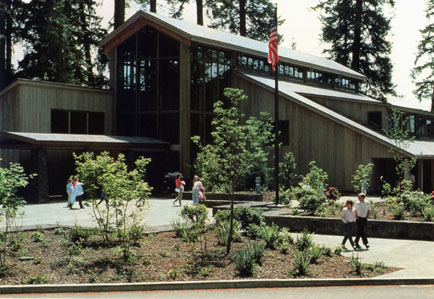
Despite the troubled economy in early 1980s, tens of thousands of visitors flocked to the area surrounding Mount St. Helens to marvel at the effects of the eruption. On August 27, 1982, President Reagan signed into law a measure setting aside 110,000 acres around the volcano as the Mount St. Helens National Volcanic Monument, the nation's first such monument managed by the USFS. At dedication ceremonies on May 18, 1983, Max Peterson, head of the USFS, said,"we can take pride in having preserved the unique episode of natural history for future generations." Since then, many trails, viewpoints, information stations, campgrounds, and picnic areas have been established to accommodate the increasing number of visitors each year. Beginning in the summer of 1983, visitors have been able to drive to Windy Ridge, only 4 miles northeast of the crater. From this spectacular vantage point overlooking Spirit Lake, people see firsthand not only the awesome evidence of a volcano's destruction, but also the remarkable, gradual recovery of the land as revegetation proceeds and wildlife returns.

The U.S. Forest Service Mount St. Helens Visitor Center near Silver Lake, Washington (Photograph by Jim Quiring, USFS Mount St. Helens Volcanic National Monument).
Mountain climbing to the summit of the volcano has been allowed since 1986, and winter exploration of the crater itself is a difficult but rewarding adventure. A majestic Visitor Center was completed in December 1986 at Silver Lake, about 30 miles west of Mount St. Helens and a few miles east of Interstate Highway 5; by the end of 1989, the Center had hosted more than 1.5 million visitors. Scheduled for opening in 1992 or 1993 is an interpretation complex in the Coldwater Lake-Johnston Ridge area, from which visitors will be able to view the inside of the crater and its dome from the site of David Johnston's camp on the morning of May 18, 1980.
The National Volcanic Monument preserves some of the best examples and
sites affected by volcanic events for scientific studies, education, and
recreation. Intensive monitoring of the volcano is now all the more important
to ensure the safety of the scientists and the monument's visitors.

People view exhibits about Mount St. Helens at the U.S. Forest Service Visitor Center (Photograph by Jim Quiring, USFS Mount St. Helens Volcanic National Monument).
![]() Scientists' Challenge
and Opportunity
Scientists' Challenge
and Opportunity
Selected Viewings and Readings![]()
URL: <https://pubs.usgs.gov/gip/msh/monument.html>
Contact: John Watson
Last updated: 06.25.97